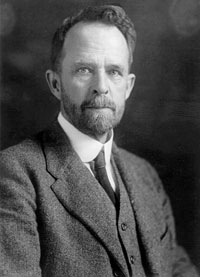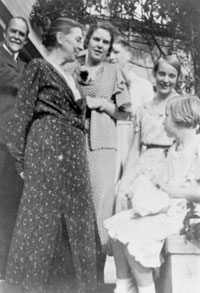 |
 |
 |
Thomas Hunt Morgan
Commemorative Symposium
July 21, 2010
2 PM – 4:30 PM
Speck Auditorium
10 MBL Street
Marine Biological Laboratory, Woods Hole
Agenda | Abstracts | Speakers
(Left) T.H. Morgan in 1920. Credit: A.F. Huettner, courtesy of MBL Archives.
|
|
|
|
 |
 |
|
(From left) T.H. Morgan, Lilian Morgan, and their daughter, Dr. Isabel Morgan Mountain, in Norway in the mid-1930s during a Scandinavian trip to collect T.H. Morgan’s Nobel Prize. Also pictured are children of Drs. Otto and Tove Mohr, who were close friends of the Morgans. Courtesy MBL Archives.
|
Agenda
Welcome and Introductory Remarks
Dr. Gary Borisy, MBL
T.H. Morgan’s Vision for Biology
Dr. Jane Maienschein, Arizona State University
T.H. Morgan: How Wrong Can You Be and Still Be Right?
Dr. Garland Allen, Washington University
Refreshment Break
Summers in Woods Hole with my Grandparents, T.H. and Lilian Morgan
Ms. Barbara Morgan Roberts
T.H. Morgan’s “Regeneration”: Paying It Forward
Dr. Alejandro Sánchez Alvarado, HHMI/University of Utah
Closing Remarks
Dr. Gary Borisy, MBL
THOMAS HUNT MORGAN’S VISION FOR BIOLOGY
Jane Maienschein
Most people know of T. H. Morgan for his Nobel Prize-winning work on the genetics of Drosophila flies, but the Woods Hole community realizes that he and his work involved so much more. In fact, Morgan was a leader of the generation that laid out the vision of what modern biology should be, and he developed and followed that vision especially at the Marine Biological Laboratory as well as through his academic year appointments at Columbia University and then Caltech. As this talk will address, that vision involved opportunism in working with many different experimental organisms, multidisciplinary thinking, collaborations, intellectual and institutional leadership, and Morgan’s appreciation of the importance of understanding scientific history. This talk will also look at Morgan’s contributions to embryology and understanding of core questions about how an individual egg cell can become a complex functioning organism. Morgan’s first and final books focus on these questions, and along with his work as an MBL leader and his contributions to genetics and evolution (to be discussed by Garland Allen) and to regeneration (as Alejandro Sanchez Alvarado will explore), they reveal his vision for biology.
T.H. MORGAN: HOW WRONG CAN YOU BE AND STILL BE RIGHT?
Garland Allen
T.H. Morgan is rightly celebrated as the main architect of the Mendelian-Chromosome Paradigm of Heredity—the idea that Mendelian factors, or genes, are arranged in a linear order along the chromosomes in the cell nucleus—and as recipient of the first Nobel Prize in genetics. It was in 1910—100 years ago—that Morgan published his famous paper detailing the sex-limited inheritance of eye color in Drosophila. Yet in the decade preceding the famous fly paper, Morgan not only expressed major doubts about the validity of Mendelian genetics itself, but also about chromosomes as agents of heredity and about the efficacy of Darwinian selection to produce adaptive change in species. Although by 1915 Morgan had changed his mind on all three issues, his critique of three of the most important paradigms in biology at the time reflects something central about Morgan’s philosophy of science in general, and his approach to the problem of heredity in particular.
SUMMERS IN WOODS HOLE WITH MY GRANDPARENTS, T.H. MORGAN AND LILIAN VAUGHAN MORGAN
Barbara Morgan Roberts
In 1906, my grandparents had a big, shingled, roomy summer house built for them and their baby son, Howard (my father) at 56 Buzzards Bay Avenue in Woods Hole. Soon, this house filled up with three more children and before long, with their children’s families. In the mid-1930s, T.H. and Lilian Morgan (“Nana” and “Papa” to me) took the long train ride from their home in Pasadena, Calif., to Woods Hole each summer, often picking me up in Kansas City to accompany them. I have wonderful memories of those Woods Hole summers—Papa showing me how to use a dissecting microscope; Nana taking us on nature walks; visits with our neighbors (the E.B. Wilsons, the F.R. Lillies, the E.C. Conklins, and others) – that I will share, along with my lasting memories of Papa and Nana, and their personalities and interests.
T.H. MORGAN’S “REGENERATION”: PAYING IT FORWARD
Alejandro Sánchez Alvarado
In January of 1900, T.H. Morgan gave five lectures on regeneration and experimental embryology at Columbia University. These lectures became the nucleation center for his book “Regeneration,” which was published in 1901. The book had immediate impact, as evidenced by a 1902 New York Times Review by M.A. Bigelow that claimed, “In ‘Regeneration’ we have an epoch-marking volume which collates the results of numerous studies in experimental zoology.” However, the book is more than a compilation of the knowledge of the time. In his preface, Morgan writes: “I have tried to use my material in such a way as to turn the evidence against some of the uncritical hypotheses of biology. I trust that the book may have a wider bearing than simply as a treatment of the problems of regeneration.” Although overshadowed by Morgan’s later work on genetics and sometimes completely forgotten by his biographers, for those of us studying regeneration, Morgan’s book has been an exemplar of scientific critique. Rather than wallow in speculation as a way to supply demonstration, Morgan’s “Regeneration” systematically distinguished the voices from the echoes by identifying both the scientific problems in regeneration and the legitimate methods to solve them. In this lecture, I will attempt to illustrate how Morgan’s critical thinking and experimentation has influenced contemporary, mechanistic studies of animal regeneration.
JANE MAIENSCHEIN is Regents’ Professor, President’s Professor, and Parents Association Professor at Arizona State University (ASU), where she is also director of the Center for Biology and Society. Her research focuses on the history and philosophy of biology, with a particular emphasis on biology, bioethics, and biopolicy in society. Dr. Maienschein is the author of several pieces on the work of T.H. Morgan, including Transforming Traditions in American Biology, 1880-1915 (Johns Hopkins University Press, 1991), which explores the careers of Morgan and three other biologists. She also directs The Embryo Project, an online encyclopedia of embryo research, past and present, that is being developed at ASU in partnership with the MBL. As part of the Embryo Project, Dr. Maienschein is documenting and interpreting the contributions of the MBL and the MBL Embryology course to the history of embryo research. Dr. Maienschein also co-directs the annual MBL-ASU History of Biology seminar at the MBL, an intensive graduate-level course. She has written extensively on the history of the MBL, including the book 100 Years Exploring Life, 1888-1988: The Marine Biological Laboratory (Jones and Bartlett Press, 1989).
GARLAND ALLEN is professor of biology at Washington University in St. Louis, and a scholar of the history and philosophy of biology. He is the author of Thomas Hunt Morgan: The Man and His Science (Princeton University Press, 1978), and has published numerous articles on the work of Morgan and his colleagues. In addition to his scholarship on the development of the Mendelian-chromosomal theory of heredity, Allen’s research interests include the general history of the life sciences and the history of eugenics. He has taught at Harvard University, where he earned his Ph.D. in History of Science in 1966, and currently teaches history of biology and introductory biology for majors at Washington University. His current work includes completing a book on the history of genetics in the 20th century, a study of the eugenics and conservation movements between 1890 and 1950, as well as a comparative study on Karl Marx, Charles Darwin, and Richard Wagner.
BARBARA MORGAN ROBERTS of Mission, Kansas, is one of the five grandchildren of Thomas Hunt Morgan and Lilian Vaughan Sampson Morgan. Largely because of her grandmother's interest in her, she has spent most of her life as a professional artist and an amateur pianist. She is very happy to be in attendance today along with her two sisters: Connie Morgan Allard of Falls Church, Virginia, and Pam Morgan Jacobsen of North Kingstown, Rhode Island.
ALEJANDRO SÁNCHEZ ALVARADO is an investigator of the Howard Hughes Medical Institute and Professor of Neurobiology and Anatomy at the University of Utah School of Medicine. The goal of his laboratory is to identify and characterize the molecular components underpinning regeneration using the freshwater planarian – an animal that Thomas Hunt Morgan also used in his studies of regeneration at the turn of the 20th century. To better understand the biology of the planarian, Dr. Sánchez Alvarado’s laboratory has developed numerous molecular tools for its study and recently finished sequencing and annotating the planarian genome. Dr. Sánchez Alvarado has been on the faculty of the MBL Embryology Course since 2004, and is a 1995 alumnus of the course. He has received numerous awards, honors, and fellowships, including the H.A. and Edna Benning Presidential Endowed Chair at the University of Utah (2010); Ellison Medical Foundation Senior Scholar Award (2009-2013), a MERIT Award from NIH/NIGMS (2009-2019); and a National Academy of Sciences Kavli Fellowship (2008). He is a member of numerous scientific and editorial boards, and has authored more than 50 scientific articles and book chapters, and two patent applications.
|